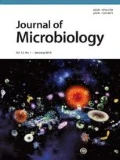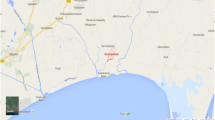Abstract
Actinomycetes are well-known for producing numerous bioactive secondary metabolites. In this study, primary screening by antifungal activity assay found one actinomycete strain WA23-4-4 isolated from the intestinal tract of Periplaneta americana that exhibited broad spectrum antifungal activity. 16S rDNA gene analysis of strain WA23-4-4 revealed close similarity to Streptomyces nogalater (AB045886) with 86.6% sequence similarity. Strain WA23-4-4 was considered as a novel Streptomyces and the 16s rDNA sequence has been submitted to GenBank (accession no. KX291006). The maximum antifungal activity of WA23-4-4 was achieved when culture conditions were optimized to pH 8.0, with 12% inoculum concentration and 210 ml ISP2 medium, which remained stable between the 5th and the 9th day. 3-Acetyl benzoyl amide was isolated by ethyl acetate extraction of WA23-4-4 fermentation broth, and its molecular formula was determined as C9H9NO2 based on MS, IR, 1H, and 13C NMR analyses. The compound showed significant antifungal activity against Candida albicans ATCC 10231 (MIC: 31.25 μg/ml) and Aspergillus niger ATCC 16404 (MIC: 31.25 μg/ml). However, the compound had higher MIC values against Trichophyton rubrum ATCC 60836 (MIC: 500 μg/ml) and Aspergillus fumigatus ATCC 96918 (MIC: 1,000 μg/ml). SEM analysis showed damage to the cell membrane of Candida albicans ATCC 10231 and to the mycelium of Aspergillus niger ATCC 16404 after being treatment with 3-acetyl benzoyl amide. In conclusion, this is the first time that 3-acetyl benzoyl amide has been identified from an actinomycete and this compound exhibited antifungal activity against Candida albicans ATCC 10231 and Aspergillus niger ATCC 16404.
Similar content being viewed by others
References
Ambavane, V., Tokdar, P., Parab, R., Sreekumar, E.S., Mahajan, G., and Mishra, P.D. 2014 Caerulomycin A-An antifungal compound isolated from marine actinomycetes. Adv. Microbiol. 9, 567–578
Ballav, S., Kerkar, S., Thomas, S., and Augustine, N. 2015 Halophilic and halotolerant actinomycetes from a marine saltern of Goa, India producing anti-bacterial metabolites. J. Biosci. Bioeng. 119, 323–330
Barka, E.A., Vatsa, P., Sanchez, L., Gaveau-Vaillant, N., Jacquard, C., Klenk, H.P., Clement, C., Ouhdouch, Y., and van Wezel, G.P. 2016 Taxonomy, physiology, and natural products of actinobacteria. Microbiol. Mol. Biol. Rev. 80, 1–43
Blodgett, J.A., Oh, D.C., Cao, S., Currie, C.R., Kolter, R., and Clardy, J. 2010 Common biosynthetic origins for polycyclic tetramate macrolactams from phylogenetically diverse bacteria. Proc. Natl. Acad. Sci. USA 107, 11692–11697
Carr, G., Poulsen, M., Klassen, J.L., Hou, Y., Wyche, T.P., Bugni, T.S., Currie, C.R., and Clardy, J. 2012 Microtermolides A and B from termite-associated Streptomyces sp. and structural revision of vinylamycin. Org. Lett. 14, 2822–2825
Chakraborty, S., Ghosh, M., Chakraborti, S., Jana, S., Sen, K.K., Kokare, C., and Zhang, L. 2015 Biosurfactant produced from Actinomycetes nocardiopsis A17 Characterization and its biological evaluation. Int. J. Biol. Macromol. 79, 405–412
Clardy, J., Fischbach, M.A., and Walsh, C.T. 2006 New antibiotics from bacterial natural products. Nat. Biotechnol. 24, 1541–1550
Currie, C.R., Scott, J.A., Summerbell, R.C., and Malloch, D. 1999 Fungus-growing ants use antibiotic-producing bacteria to control garden parasites. Nature 6729, 701–704
Goudjal, Y., Toumatia, O., Yekkour, A., Sabaou, N., Mathieu, F., and Zitouni, A. 2014 Biocontrol of Rhizoctonia solani damping-off and promotion of tomato plant growth by endophytic actinomycetes isolated from native plants of Algerian Sahara?. Microbiol. Res. 169, 59–65
Guo, Z.K., Liu, S.B., Jiao, R.H., Wang, T., Tan, R.X., and Ge, H.M. 2012 Angucyclines from an insect-derived actinobacterium Amycolatopsis sp. HCa1 and their cytotoxic activity. Bioorg. Med. Chem. Lett. 22, 7490–7493
Hasegawa, S., Meguro, A., Shimizu, M., Nishimura, T., and Kunoh, H. 2006 Endophytic actinomycetes and their interactions with host plants. Actinomycetologica 2, 72–81
Hwang, K.S., Kim, H.U., Charusanti, P., Palsson, B.Q., and Lee, S.Y. 2014 Systems biology and biotechnology of Streptomyces species for the production of secondary metabolites. Biotechnol. Adv. 32, 255–268
Jeyanthi, V., Anbu, P., Vairamani, M., and Velusamy, P. 2016 Isolation of hydroquinone (benzene-1,4-diol) metabolite from halotolerant Bacillus methylotrophicus MHC10 and its inhibitory activity towards bacterial pathogens. Bioprocess Biosyst. Eng. 39, 429–439
Kaltenpoth, M. and Engl, T. 2014 Defensive microbial symbionts in hymenoptera. Funct. Ecol. 2, 315–327
Katz, L. and Baltz, R.H. 2016 Natural product discovery: Past, present, and future. J. Ind. Microbiol. Biotechnol. 43, 155–176
Kim, O.S., Cho, Y.J., Lee, K., Yoon, S.H., Kim, M., Na, H., Park, S.C., Jeon, Y.S., Lee, J.H., Yi, H., et al. 2012 Introducing EzTaxon-e: A prokaryotic 16S rRNA gene sequence database with phylotypes that represent uncultured species. Int. J. Syst. Evol. Microbiol. 62, 716–721
Kim, M.C., Lee, J., Kim, D.H., Son, H.J., and Heo, M.S. 2014 Isolation and identification of antioxidant producing marine-source actinomycetes and optimal medium conditions. Food Sci. Biotechnol. 5, 1629–1635
Kroiss, J., Kaltenpoth, M., Schneider, B., Schwinger, M.G., Hertweck, C., Maddula, R.K., Strohm, E., and Svatos, A. 2010 Symbiotic streptomycetes provide antibiotic combination prophylaxis for wasp offspring. Nat. Chem. Biol. 6, 261–263
Kumar, S. and Kannabiran, K. 2010 Antifungal activity of Streptomyces VITSVK5 spp. against drug resistant Aspergillus clinical isolates from pulmonary tuberculosis patients. J. Mycol. Med. 2, 101–107
Madden, A.A., Grassetti, A., Soriano, J.A., and Starks, P.T. 2013 Actinomycetes with antimicrobial activity isolated from paper wasp (Hymenoptera: Vespidae: Polistinae) nests. Environ. Entomol. 42, 703–710
Magarvey, N.A., Keller, J.M., Bernan, V., Dworkin, M., and Sherman, D.H. 2004 Isolation and characterization of novel marine-derived actinomycete taxa rich in bioactive metabolites. Appl. Environ. Microbiol. 70, 7520–7529
Mendes, R., Kruijt, M., de Bruijn, I., Dekkers, E., van der Voort, M., Schneider, J.H., Piceno, Y.M., DeSantis, T.Z., Andersen, G.L., Bakker, P.A., et al. 2011 Deciphering the rhizosphere microbiome for disease-suppressive bacteria. Science 332, 1097–1100
Mondol, M.A.M., Tareq, F.S., Kim, J.H., Lee, M., Lee, H.S., Lee, Y.J., Lee, J.S., and Shin, H.J. 2011 Cyclic ether-containing macrolactins, antimicrobial 24-membered isomeric macrolactones from a marine Bacillus sp. J. Nat. Prod. 74, 2582–2587
Oliver, K.M., Smith, A.H., Russell, J.A., and Clay, K. 2014 Defensive symbiosis in the real world–advancing ecological studies of heritable, protective bacteria in aphids and beyond. Funct. Ecol. 28, 341–355
Otani, S., Mikaelyan, A., Nobre, T., Hansen, L.H., Kone, N.A., Sorensen, S.J., Aanen, D.K., Boomsma, J.J., Brune, A., and Poulsen, M. 2014 Identifying the core microbial community in the gut of fungus-growing termites. Mol. Ecol. 23, 4631–4644
Pratiwi, R.H., Hidayat, I., Hanafi, M., and Mangunwardoyo, W. 2017 Antibacterial compound produced by Pseudomonas aeruginosa strain UICC B-40, an endophytic bacterium isolated from Neesia altissima. J. Microbiol. 55, 289–295
Scott, J.J., Oh, D.C., Yuceer, M.C., Klepzig, K.D., Clardy, J., and Currie, C.R. 2008 Bacterial protection of beetle-fungus mutualism. Science 322, 63
Selvin, J., Shanmughapriya, S., Gandhimathi, R., Seghal Kiran, G., Rajeetha Ravji, T., Natarajaseenivasan, K., and Hema, T.A. 2009 Optimization and production of novel antimicrobial agents from sponge associated marine actinomycetes Nocardiopsis dassonvillei MADo8 Appl. Microbiol. Biotechnol. 83, 435–445
Shirling, E.B. and Gottlieb, D. 1966 Methods for characterization of Streptomyces species1 Int. J. Syst. Evol. Microbiol. 16, 313–340
Tamura, K., Peterson, D., Peterson, N., Stecher, G., Nei, M., and Kumar, S. 2011 Mega5 Molecular evolutionary genetics analysis using maximum likelihood, evolutionary distance, and maximum parsimony methods. Mol. Biol. Evol. 28, 2731–2739
Watson, C.Y., Whish, W.J., and Threadgill, M.D. 1998 Synthesis of 3-substituted benzamides and 5-substituted isoquinolin-1(2H)-ones and preliminary evaluation as inhibitors of poly(ADP-ribose) polymerase (PARP). Bioorg. Med. Chem. 6, 721–734
Xiong, Z.Q., Liu, Q.X., Pan, Z.L., Zhao, N., Feng, Z.X., and Wang, Y. 2015 Diversity and bioprospecting of culturable actinomycetes from marine sediment of the Yellow Sea, China. Arch. Microbiol. 197, 299–309.
Author information
Authors and Affiliations
Corresponding author
Rights and permissions
About this article
Cite this article
Fang, X., Shen, J., Wang, J. et al. Antifungal activity of 3-acetylbenzamide produced by actinomycete WA23-4-4 from the intestinal tract of Periplaneta americana. J Microbiol. 56, 516–523 (2018). https://doi.org/10.1007/s12275-018-7510-z
Received:
Revised:
Accepted:
Published:
Issue Date:
DOI: https://doi.org/10.1007/s12275-018-7510-z




